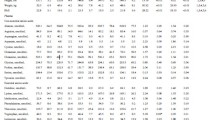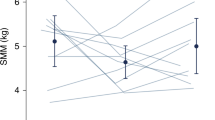Abstract
Objectives
To evaluate changes in serum magnesium and phosphate over time in hospitalised older patients, examine whether such changes were associated with changes in muscle strength, and assess whether risk factors for refeeding syndrome were associated with falls in serum magnesium and phosphate.
Design and Setting
Community dwelling patients aged 70 and over, admitted to a specialist Medicine for the Elderly assessment unit were included in a prospective study.
Measurements
Weight, height, triceps skinfold thickness and mid arm circumference were recorded at baseline. Serum magnesium and phosphate was measured on admission, and at days 1, 2, 3, 5, 7, 10, 14, 21, 28 after admission, along with handgrip and quadriceps strength measured in the non-dominant limbs using a portable dynamometer.
Results
43 patients were recruited with a mean age of 83.8 years (SD 7.5). 58% were female. Mean baseline serum magnesium and phosphate levels were 0.89mmol/L and 1.07mmol/L respectively. 10/43 patients had a fall in serum magnesium of at least 0.2mmol/l from baseline and 20/43 had a similar fall in phosphate. No correlation was shown between these changes in electrolytes and muscle strength. Regression analyses did not show that risk factors for refeeding syndrome were associated with falls in electrolyte levels.
Conclusion
Changes in serum magnesium and phosphate levels do not correlate with changes in muscle strength in older hospitalised patients. Risk factors for refeeding syndrome did not predict falls in serum phosphate or magnesium.
Similar content being viewed by others
References
Sumukadas D, Jenkinson F, Witham MD. Associations and consequences of hypophosphataemia in older hospitalised women. Age Ageing 2009;38:112–115.
Kagansky N, Levy S, Koren-Morag N, Berger D, Knobler H. Hypophosphataemia in old patients is associated with the refeeding syndrome and reduced survival. J Intern Med 2005;257:461–468.
Ralston MA, Murnane MR, Kelley RE, Altschud RA, Unverferth DV, Leier CV. Magnesium content of serum, circulating mononuclear cells, skeletal muscle, and myocardium in congestive heart failure. Circulation 1989;80:573–580.
Dorup I, Skajaa K, Clausen T, Kjeldsen K. Reduced concentrations of potassium, magnesium, and sodium-potassium pumps in human skeletal muscle during treatment with diuretics. BMJ 1988;296:455–458.
Aagaard NK, Andersen H, Vilstrup H, Clausen T, Jakobsen J, Dorup I. Decreased muscle strength and contents of Mg and Na,K-pumps in chronic alcoholics occur independently of liver cirrhosis. J Intern Med 2003;253:359–366.
Crook MA, Hally V, Panteli JV. The importance of the refeeding syndrome. Nutrition 2001;17:632–637.
Dominguez LJ, Barbagallo M, Lauretani F, et al. Magnesium and muscle performance in older persons: the InCHIANTI study. Am J Clin Nutr 2006;84:419–426.
Zazzo JF, Troche G, Ruel P, Maintenant J. High incidence of hypophosphatemia in surgical intensive care patients: efficacy of phosphorus therapy on myocardial function. Intensive Care Med 1995;21:826–831.
Syddall H, Cooper C, Martin F, Briggs R, Aihie SA. Is grip strength a useful single marker of frailty? Age Ageing 2003;32:650–656.
Martin HJ, Yule V, Syddall HE, Dennison EM, Cooper C, Aihie SA. Is hand-held dynamometry useful for the measurement of quadriceps strength in older people? A comparison with the gold standard Biodex dynamometry. Gerontology 2006;52:154–159
Wang CY, Olson SL, Protas EJ. Test-retest strength reliability: hand-held dynamometry in community-dwelling elderly fallers. Arch Phys Med Rehabil 2002;83:811–815.
Elia M: Screening for Malnutrition: A Multidisciplinary Responsibility. Development and Use of the Malnutrition Universal Screening Tool (MUST) for Adults. Malnutrition Advisory Group (MAG), a Standing Committee of BAPEN. Redditch, Worcs.: BAPEN 2003
Charlson ME, Pompei P, Ales KL, MacKenzie CR. A new method of classifying prognostic comorbidity in longitudinal studies: development and validation. J Chronic Dis 1987;40:373–383
Folstein MF, Folstein SE, McHugh PR. “Mini-mental state”. A practical method for grading the cognitive state of patients for the clinician. J Psychiatr Res 1975;12:189–198.
Levey AS, Bosch JP, Lewis JB, Greene T, Rogers N, Roth D. A more accurate method to estimate glomerular filtration rate from serum creatinine: a new prediction equation. Modification of Diet in Renal Disease Study Group. Ann Intern Med 1999;130:461–470.
Cundy T, Dissanayake A. Severe hypomagnesaemia in long-term users of protonpump inhibitors. Clin Endocrinol 2008;69:338–341.
Bohannon RW. Hand-grip dynamometry predicts future outcomes in aging adults. J Geriatr Phys Ther 2008;31:3–10.
Amanzadeh J, Reilly RF. Hypophosphatemia: an evidence-based approach to its clinical consequences and management. Nat Clin Pract Nephrol 2006;2:136–148.
Author information
Authors and Affiliations
Corresponding author
Rights and permissions
About this article
Cite this article
Henderson, S., Boyce, F., Sumukadas, D. et al. Changes in serum magnesium and phosphate in older hospitalised patients — Correlation with muscle strength and risk factors for refeeding syndrome. J Nutr Health Aging 14, 872–876 (2010). https://doi.org/10.1007/s12603-010-0261-0
Received:
Accepted:
Published:
Issue Date:
DOI: https://doi.org/10.1007/s12603-010-0261-0




